eMDE – Ben’s Blog: Green & Purple Shine in 2017 Laws
THE LATEST FROM THE MARYLAND DEPARTMENT OF THE ENVIRONMENT

Green and Purple Shine in 2017 Laws
Here’s some good news from Annapolis, where the General Assembly concluded its annual 90 day session on April 10: lots of environmental “green” wins and bipartisan “purple” collaborations between legislators and Governor Larry Hogan. The General Assembly enacted Governor Hogan’s environmental legislative initiatives, including clean energy and clean water proposals to advance the market for electric vehicles and restore our treasured Chesapeake Bay. The Governor also played a leading role in shaping the regulatory and legislative debate on hydraulic fracturing, ultimately signing into law a ban on the practice in Maryland. Lawmakers approved all of our department’s bills, including a measure that requires dam owners to submit plans for responding to emergencies in the event of a failure and another that streamlines the process for a landlord to be notified that a child living at the property has been diagnosed with lead poisoning.
These bipartisan actions will advance environmental progress while greening and growing Maryland’s economy.
Clean Water Partnerships
The aptly titled Clean Water Commerce Act (HB417/SB314) expands the authorized uses of the Bay Restoration Fund to include the purchase of cost-effective nitrogen, phosphorus or sediment load reductions in support of Maryland’s efforts to restore the health of the Chesapeake Bay. The Bay Restoration Fund’s sewer fees primarily provide grants to upgrade major municipal sewage treatment plants, along with grants for other nutrient reduction projects such as sewer hookups for failing septic systems and reducing combined sewer overflows. The Clean Water Commerce Act eventually allows up to $10 million a year to be spent on pollution reductions.
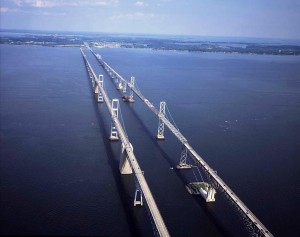 The act is consistent with the recommendations of a report by the University of Maryland Environmental Finance Center, which stated that Bay restoration is achievable in Maryland and resources are in place but there must be a renewed focus on cost efficiency, innovation and effectiveness. The act focuses on measureable environmental outcomes, and it is intended to lower the costs of meeting federal Bay restoration pollution limits.
The act is consistent with the recommendations of a report by the University of Maryland Environmental Finance Center, which stated that Bay restoration is achievable in Maryland and resources are in place but there must be a renewed focus on cost efficiency, innovation and effectiveness. The act focuses on measureable environmental outcomes, and it is intended to lower the costs of meeting federal Bay restoration pollution limits.
Energized for Cleaner Energy
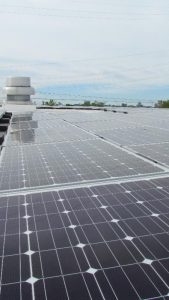 The Clean Cars Act of 2017 (HB406) extends and increases incentives for buying plug-in electric vehicles and providing the supporting infrastructure. It extends the end date for tax credits for buying these vehicles and for rebates for recharging equipment. Transportation accounts for a third of the state’s nitrogen oxide emissions, which contribute significantly to Maryland’s ground level ozone problem and harmful nitrogen deposition into the Bay. We believe plug-in electric vehicles provide one of the best solutions to reducing these emissions while allowing Maryland’s economy to continue to grow. The act builds upon the Maryland Clean Cars Act of 2007, which included a requirement for automobile manufacturers to place a growing number of zero emissions vehicles for sale in Maryland. The incentives in the 2017 act are vital to the success of this program.
The Clean Cars Act of 2017 (HB406) extends and increases incentives for buying plug-in electric vehicles and providing the supporting infrastructure. It extends the end date for tax credits for buying these vehicles and for rebates for recharging equipment. Transportation accounts for a third of the state’s nitrogen oxide emissions, which contribute significantly to Maryland’s ground level ozone problem and harmful nitrogen deposition into the Bay. We believe plug-in electric vehicles provide one of the best solutions to reducing these emissions while allowing Maryland’s economy to continue to grow. The act builds upon the Maryland Clean Cars Act of 2007, which included a requirement for automobile manufacturers to place a growing number of zero emissions vehicles for sale in Maryland. The incentives in the 2017 act are vital to the success of this program.
Another of the Governor’s initiatives (SB313/HB410) establishes the Maryland Energy Innovation Institute in the A. James Clark School of Engineering at the University of Maryland, College Park. The mission of the institute will be to develop and attract private investment and commercialize clean energy innovations in Maryland.
Our Department’s Legislation
 The General Assembly passed our bill (HB133) to speed required repairs and inspections of properties where a child has been diagnosed with lead poisoning. Instead of our department notifying the local government of a diagnosis and that government in turn notifying the property owner and tenants, our department will notify them directly. We are making progress but have much more to do to win the battle against childhood lead poisoning in Maryland. Removing that extra step in the process and speeding the response is a common sense way to strengthen our lead poisoning prevention program’s efforts to eliminate this completely preventable disease.
The General Assembly passed our bill (HB133) to speed required repairs and inspections of properties where a child has been diagnosed with lead poisoning. Instead of our department notifying the local government of a diagnosis and that government in turn notifying the property owner and tenants, our department will notify them directly. We are making progress but have much more to do to win the battle against childhood lead poisoning in Maryland. Removing that extra step in the process and speeding the response is a common sense way to strengthen our lead poisoning prevention program’s efforts to eliminate this completely preventable disease.
Another measure (HB125) requires that owners of dams prepare and, if necessary, execute emergency action plans to evacuate people and close roads if a dam failure is imminent. The failure of a dam can cause loss of life or significant property damage.
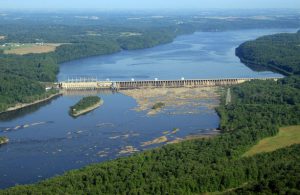 Anyone who applies to our department to construct a new dam or repair an existing dam is required to prepare an EAP as a permit condition. While many other dam owners have prepared EAPs, this bill gives the department the authority to require all owners of dams that present a significant hazard to prepare a plan for our approval.
Anyone who applies to our department to construct a new dam or repair an existing dam is required to prepare an EAP as a permit condition. While many other dam owners have prepared EAPs, this bill gives the department the authority to require all owners of dams that present a significant hazard to prepare a plan for our approval.
A department bill (HB121) repeals a law that requires facilities that store, dispense, use or handle certain amounts of hazardous materials conduct and submit self-audits to our department. The law was enacted prior to the establishment of a comprehensive federal security program regulating chemical facilities, and it is no longer needed. It is an example of common sense regulatory reform that removes unnecessary burdens to our businesses with no cost to the environment or public health.
Another environmental measure (HB124) sailed through to clarify when recycling facilities must obtain refuse disposal permits. The current lack of clarity could impose a longer, more burdensome permitting process on the recycling industry. Because of the bill, new regulations will establish clear conditions for when a permit is or is not required. It’s another example of smart reform that’s good for our environment and our economy.
Other Good Outcomes
Hydraulic fracturing (HB1325) – Earlier this month, Governor Hogan signed a measure that bans hydraulic fracturing, or “fracking,” in Maryland. In announcing his support for a ban, the Governor noted that our department had proposed the toughest regulations in the country – and that those regulations “would have made it virtually impossible for anyone to ever engage in fracking in Maryland.” He said he decided that “we must take the next step and move from virtually banning fracking to actually banning fracking.”
“Because of Maryland’s unique position in the country and our wealth of natural resources, our administration has concluded that the possible environmental risks of fracking simply outweigh any potential benefits,” Governor Hogan said. “Protecting our clean water supply and our natural resources is critically important to Marylanders, and we simply cannot allow the door to be opened for fracking in our state.”
Agriculture – Maryland Healthy Soils Program (HB1063): The bill establishes a healthy soil program at the Maryland Department of Agriculture. This widely supported initiative, which Maryland’s Climate Change Commission has embraced, will increase soil productivity, carbon capture and environmental resiliency.
Bay Restoration Fund – Eligible Costs – Expansion (SB343/HB384): The bill expands eligible costs to include facilities going to enhanced nutrient removal technology (ENR); it would include biological nutrient removal technology (BNR) upgrades, as well.
Labeling of Compostable and Organic Materials (HB1349): The bill establishes labeling requirements for certain plastic products, effective October 1, 2018, and generally prohibits a person from selling a plastic product that is labeled as biodegradable, degradable, decomposable or a similar term. The bill also prohibits a person from selling a plastic product labeled as compostable or home compostable unless the product meets a specified standard. Finally, the bill establishes specific labeling requirements for compostable plastic bags and compostable food or beverage products sold or distributed in the state.
 Department of the Environment – Yard Waste, Food Residuals, and Other Organic Materials Diversion and Infrastructure – Study (SB99/HB171): The bill requires MDE to do a study on diversion of yard waste, food residuals and other organics. It should include a study on anaerobic digestion. There’s growing support in Maryland for sustainable materials management, including increased yard waste and food residual diversion. There is also a general recognition that more emphasis needs to be placed on establishing the necessary infrastructure to support these activities. The department continues to build on past successes in recycling while looking toward such new frontiers as food composting.
Department of the Environment – Yard Waste, Food Residuals, and Other Organic Materials Diversion and Infrastructure – Study (SB99/HB171): The bill requires MDE to do a study on diversion of yard waste, food residuals and other organics. It should include a study on anaerobic digestion. There’s growing support in Maryland for sustainable materials management, including increased yard waste and food residual diversion. There is also a general recognition that more emphasis needs to be placed on establishing the necessary infrastructure to support these activities. The department continues to build on past successes in recycling while looking toward such new frontiers as food composting.
Environment – Recycling – Special Events (HB1309/SB885): The bill strengthens the current requirement that public events must have recycling. It’s important to reduce the footprint and increase the education.
Property Tax Credit – Erosion Control Measures – Nonstructural and Structural Shoreline Stabilization (SB 108). This bill will enhance Maryland’s efforts to promote living shorelines that preserve the natural environment.
Environment – Water Management – Sediment Control at Large Redevelopment Sites (HB557/SB440): The bill gives the authority to MDE to approve sediment and erosion plans for large industrial sites, which are typically complex in nature and have multimedia issues. MDE review of these plans will ensure proper coordination and oversight.
Products that Contain Mercury – Prohibition on Sale of Electric Switches, Electric Relays, and Gas Valve Switches (HB504/SB713): The bill prohibits the sale of mercury containing products after October 1, 2018.
Environment – Lead and Mercury Wheel Weights – Prohibited (HB 066): The bill prohibits the sale of lead and mercury wheel weights for the State fleet and general public.
Lead in Drinking Water at Schools (HB270). The bill requires additional action to reduce the risk of lead- contaminated water at public schools. MDE will work with stakeholders to adopt regulations to implement this legislation, including requiring initial testing to be conducted by July 1, 2018, and establishing remedial actions for positive test results.
On-Site Sewage Disposal Systems – Membrane Bioreactor (MBR) Technology – Regulations (HB1045): The bill requires MDE to encourage MBR technologies by adopting regulations. It’s important to pursue innovations that can reduce the amount of land required while still meeting environmental standards.
The 3 R’s of Best Available Treatment Technology (SB266/HB281): The House and Senate had extensive debates over the technology standard for septic systems. In the end, the legislature left in place the targeted regulatory reforms issued by MDE in November. Those regulations keep in place the BAT standard for septics in the critical areas of the Bay but provide greater flexibility for local governments throughout the state to rely on other technologies and strategies, including mandatory pump-outs and enforcement tools and re-thinking the value of sewer lines and replacement of failing septics. (The three R’s of the septics regulation: Reform, Re-tool, and Re-think.)
Energy Efficiency (SB184/HB514): The legislature codified the state EMPOWER program, which provides requirements and resources for energy conservation and efficiency.
Finding Common Ground
As Governor Hogan said upon the conclusion of the session, this is how government is supposed to work. Through teamwork and collaboration – including bipartisan support within the General Assembly – we can advance the greening of Maryland while maintaining our economic competitiveness and demonstrating to the nation that purple means progress.
What are your thoughts? Please share them by contacting Ben at editor.mde@maryland.gov.
In the News
Cumberland Times-News: Students plant 2,000 trees at abandoned strip mine
More than 50 high school students volunteered to help the Maryland Department of the Environment plant nearly 2,000 trees on a reclaimed strip mine near Frostburg.
Baltimore Sun: Hogan announces support for fracking ban in Maryland
Gov. Larry Hogan announced he supports banning fracking. The Republican governor said passing legislation to prohibit fracking was “an important initiative to safeguard our environment.”
Air, Land, Water – Did you Know?
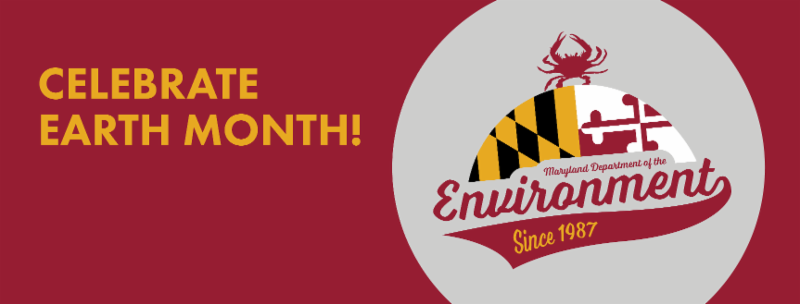
 Department of Environment kicks off Earth Month activities with employee clean-up event on the banks of the Patapsco River
Department of Environment kicks off Earth Month activities with employee clean-up event on the banks of the Patapsco River
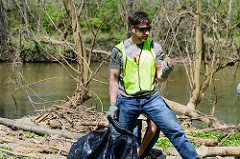
MDE’s Tim Fox
In partnership with the Patapsco Heritage Greenway, 25 MDE employees and more than 30 community volunteers removed trash and debris from the parkland areas surrounding the Patapsco River on the border of Baltimore and Anne Arundel counties. The area is in a floodplain and prone to heavy illegal dumping.
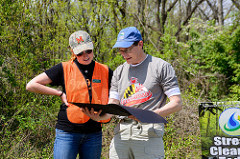
Secretary Ben Grumbles presents Governor’s Earth Month proclamation to Hannah Zinnert, Patapsco Heritage Greenway program manager
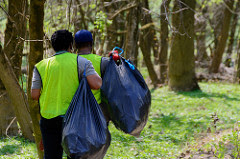
Kasarachi Omo-Osagie, Marsha Mason
Find volunteer opportunities
Department of the Environment develops guidelines for reuse of dredged material
Newly developed Maryland Department of the Environment guidelines will help allow for dredged material to be safely reused in innovative ways that protect and benefit the environment.
The Department of the Environment developed the draft guidelines in collaboration with the Maryland Department of Transportation’s Port Administration (MPA). The draft guidelines are for reuse of dredged materials, as an alternative to disposal, for such purposes as: fill for brownfields redevelopment; construction and roads; landfill cover; and restoration or creation of aquatic habitats such as marshes. They are designed to clarify regulatory requirements – and, in turn, encourage further private sector innovation in using dredged materials to benefit water quality or as useful products.
“Putting valuable material to work for communities and ecosystems makes sense, and the Maryland Department of the Environment is providing a road map to doing just that in ways that protect public health and benefit the environment,” said Maryland Secretary of the Environment Ben Grumbles. “Through science, innovation and public-private collaboration, we can advance the greening of Maryland and strengthen our economy with valuable dredged materials.”
A public information meeting on the draft guidelines was held April 25. The comment period runs through May 26.
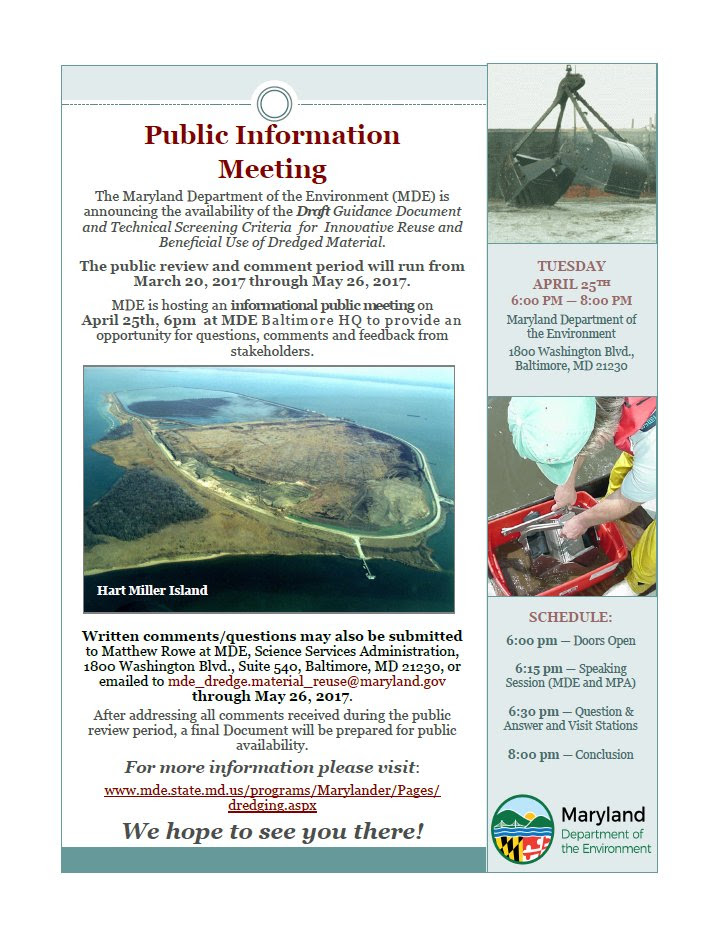
Have an Idea?
Email the Editor
 We’re always looking for ways to make eMDE even better. Here’s a chance to tell us what you think. Have some thoughts on what we can do better or things you’d like to see more of? An idea for a specific story? We want to hear from you. Contact us at editor.mde@maryland.gov.
We’re always looking for ways to make eMDE even better. Here’s a chance to tell us what you think. Have some thoughts on what we can do better or things you’d like to see more of? An idea for a specific story? We want to hear from you. Contact us at editor.mde@maryland.gov.
MDE’s Mission
Our mission is to protect and restore the quality of Maryland’s air, water, and land resources, while fostering smart growth, a thriving and sustainable economy and healthy communities.


